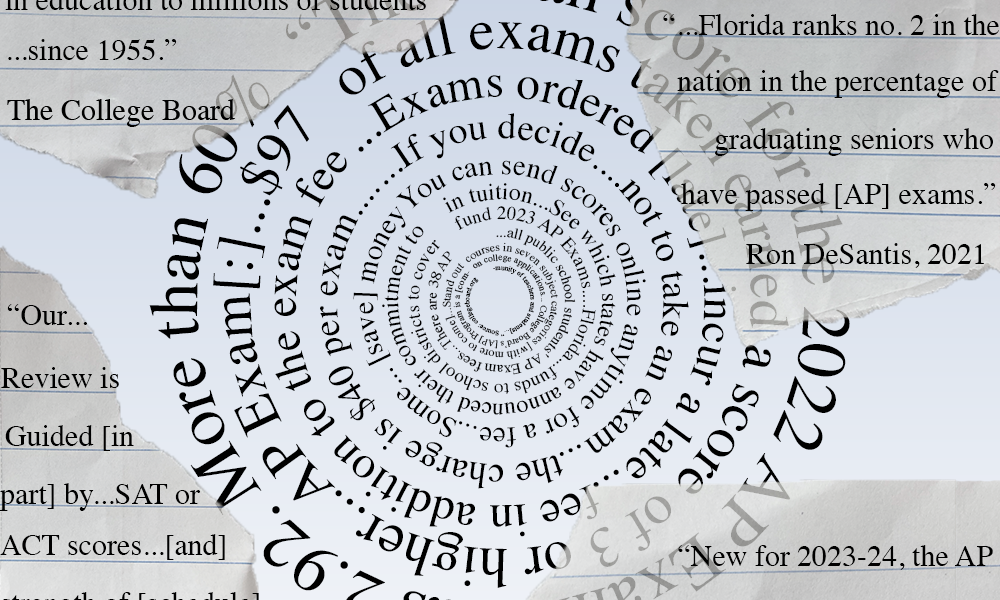By James Grossmann and Ben Black
The College Board’s Advanced Placement (AP) program serves as a program of interest to high school students looking for an opportunity to get ahead in their education and build strong college applications. The College Board currently offers 38 AP courses that are built around an AP exam, 28 of which are currently offered at Ponte Vedra High School (PVHS). An AP exam is scored from a one to a five, with the College Board recommending that colleges grant students who score a three or above on an AP exam college credit for a comparable course. This means that a student could, in theory, alleviate several of their college degree requirements while still in high school if they score passing grades on multiple AP exams.
The College Board, a nonprofit organization, charges 97 dollars each for most AP exams, a price that has increased in most recent years. The high price for AP Exams, while certainly cheaper than their college course tuition counterpart, means that taking AP exams can require a significant financial investment. This cost becomes compounded when students take multiple AP classes, often paying hundreds of dollars to try to attain college credit and give their transcript the allure of a more difficult “strength of schedule.” In order to bridge the gap between financially disadvantaged students and those who can afford these fees, some state and local governments across the U.S have implemented programs aimed at increasing equity in AP testing. In the state of Florida, public school students are exempted from the cost of AP exams via the Florida Education Finance Program, which grants school districts state funds for AP related costs. In essence, this means the state of Florida pays for every AP exam taken by public school students. Unfortunately, many other governments in both the U.S and other nations do not have policies like this, meaning students and their families must pay these expenses themselves.
Despite the costs, AP enrollment has risen drastically in recent years. On a national level, the College Board reports that 40 percent of the nationwide class of 2018 took an AP exam, a dramatic 15 percent increase from 2008 levels. At PVHS, there are over 1,150 students currently enrolled in at least one AP course for the 2022-2023 school year, with a current total of over 2,900 AP exams to be taken. The bill PVHS will have to pay for these exams this year currently totals about 265,000 dollars, but this staggering figure may slightly change as the AP exams get closer due to miscellaneous factors that might reduce the price, such as students dropping out of AP classes.
“The bill PVHS will have to pay for [AP] exams this year currently totals about 265,000 dollars”
Dr. Fredrik Oberkehr, the principal of PVHS, stated that PVHS receives an “AP allocation” from the St. Johns County School District (SJCSD) via the Florida Department of Education’s (FLDOE) Education Finance Program, mentioned above, each year to cover AP related costs. Dr. Oberkehr estimated that this allocation totals to about one million dollars each year, with roughly a quarter of it being dedicated to paying for the exams. Dr. Oberkehr also estimated that about 100,000 dollars of the remainder of the allocation from the state is used to pay out AP teachers bonuses based on their exam pass rates. A significant portion of the rest of the fund is used to pay for some AP teacher salaries and benefits, which allows the school to have more teaching positions, allowing the school to have lower class sizes and offer more classes. Some of the money is also used on items such as AP textbooks (which, unlike standard and honors classes, are not covered by SJCSD), with the rest of the money in reserve with the explicit purpose of supporting AP courses and classes that “lead to an AP course,” says Dr. Oberkehr.
In the 2021 AP exam administration, the College Board reports that the mean AP exam score was a 2.80 and that over 60 percent of exams taken earned a three or higher. In contrast, at PVHS, the total AP exam pass rate in the 2021-2022 school year was 81 percent. Dr. Oberkehr attributes this extraordinarily impressive success to PVHS having a well-motivated student body and excellent faculty and staff.
“At PVHS, the total AP exam pass rate in the 2021-2022 school year was 81 percent”
However, many schools throughout the nation do not share this story. In many low-income and rural schools, if the schools offer AP courses, many students do not have the option to take the AP exam at the end of the course due to the high cost associated with it. This is a trend that has been prevalent for years, and the College Board has been working to reduce it. One such way they are working to reduce this phenomenon is by pressuring state legislators to work to fund AP programs. According to collegeboard.org, “[the College Board] recommend[s] that…state[s] and districts…prioritize funding for low-income students’ AP Exam fees.”
Secondary education has been an important political talking point for years, and AP exams have been no exception. In some regards, an entire nation of legislators has bended to the College Board’s will in this way. The thinking goes that if government funding is used for College Board programs, politicians can reap easy political publicity in response. State politicians have often been comparing their state’s AP data to national averages. One example is Florida Governor Ron DeSantis, who has used AP data for political publicity during his term. In DeSantis’ 2021 “State of the State” address, he noted Florida ranked second in the nation for number of graduating seniors who have passed AP exams. This is almost certainly due in part to the fact that Florida funds AP exams for public school students.
An AP exam itself is a cumulative assessment administered in May of each school year. AP exams are comprised of both multiple choice and free response tests, and each AP exam’s structure differs significantly from another. AP exams and classes cover the same subject areas that a student learns in school, such as English, U.S. history, and world languages. These exams are often very challenging and require students to grasp complicated, higher-level concepts than those found in a typical standard or honors course. This makes getting the bare minimum score to “pass” an AP exam no easy feat. In addition, if a college or university offers credits for passing AP scores, they are not guaranteed to have the credit granted in college. For example, at the University of Florida, scoring a three on the AP English Language and Composition exam would net credit for a comparable argumentative and expository writing class. However, scoring a four or a five would also net credit for a persuasive writing class as well. In addition to this, many universities do not value AP exam scores the way that the College Board recommends, with some setting the bar for credit at achieving a four or a five on the exam, and some universities outright do not accept AP exam scores for credit.
Even outside of AP exams, there are other expenses students pay to the College Board. The College Board also offers the SAT, which is pivotal to many students’ college application, arguably more important than AP scores to many students. The SAT has a registration fee of 55 dollars, and students often take it two, three, or more times. There is also a cost of 16 dollars to send scores to universities that a student applies to. State funding has also helped in this regard; for example, the state of Florida is covering the expenses of one SAT or ACT school day in each school district in the state sometime during the school year. However, the fact remains that students often end up paying hundreds of dollars to the College Board even outside of AP exams.
Legislators have been working for years to help students be able to succeed in high school and beyond. Government funding has allowed students in 31 of 50 states to receive assistance in some manner for taking AP exams. The College Board has been working to push state legislators in every state to fund AP exams for students. While state funding has allowed low-income families in some areas to have more access to AP exams, the College Board has been raking in massive profits. Even during the COVID-19 pandemic in 2020 and 2021, the College Board made over 300 million dollars in profits during this period, according to an audit. Furthermore, the College Board has been expanding the AP program even further in recent years. A few years ago, the College Board debuted the AP Capstone Diploma, which requires students to take a minimum of six AP classes – two of which must be AP Seminar and AP Research, classes which have a higher AP exam cost than other AP exams at 145 dollars – in order to attain it. In the current year, the College Board is now debuting AP Precalculus and AP African American Studies. With how competitive college admissions have become, largely due to AP courses and SAT scores being very important to college admission decisions, many low-income students are inherently disadvantaged due to their lack of access to testing, even while the College Board CEO David Coleman makes nearly two million dollars a year.





